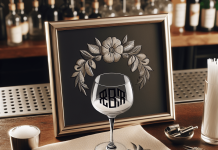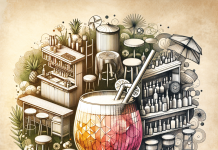Shaking has become a signature cocktail move that adds flair and style to mixology.
However, not all cocktails are meant to be shaken vigorously. Understanding which cocktails should not be shaken is essential to creating a balanced and flavorful drink.
Knowing the shaken-canvas limitations can elevate your mixing skills to a whole new level, whether you’re a seasoned bartender or a cocktail enthusiast.
Join us as we explore the delicate dance between shaking and stirring and discover the cocktails that prefer a gentle touch.
Shaking cocktails is a common practice in the bartending world. It’s a technique that helps to mix the ingredients thoroughly and create a consistent and well-balanced drink. However, not all cocktails are meant to be shaken.
There are several reasons why sure cocktails should be stirred instead. This article will explore the reasons behind this and provide a comprehensive list of cocktails that are best enjoyed when stirred.
Reasons for Not Shaking Certain Cocktails
Preserving Texture
One of the main reasons for not shaking cocktails is to preserve their texture. Shaking vigorously can sometimes result in an overly frothy or foamy drink.
This is especially true for cocktails that contain delicate ingredients such as eggs or cream. You can gently stir these cocktails to maintain a smooth, velvety texture without unwanted foam.
Preventing Over-Dilution
Another reason to stir cocktails instead of shaking them is to prevent over-dilution. When a cocktail is shaken, it comes into contact with more ice, leading to a higher dilution rate.
This can be detrimental to cocktails with a delicate balance of flavors, as it can water down the taste significantly. Stirring allows for a slower dilution process, ensuring the cocktail remains perfectly balanced.
Maintaining Carbonation
Cocktails that contain carbonated components, such as soda water or champagne, should never be shaken. The shaking process can cause these carbonated ingredients to lose their fizz and go flat. To preserve the drink’s carbonation and effervescence, gentle stirring is the way to go.
Avoiding Bruised or Muddled Herbs
Many cocktails incorporate fresh herbs or leaves in their recipes to add a vibrant and aromatic element to the drink.
When these herbs are shaken vigorously, they can become bruised or muddled, releasing an overpowering and sometimes bitter taste. Stirring allows for a more delicate infusion of the herb’s flavors without compromising their integrity.
Retaining Layered Presentation
Some cocktails are famous for their visually appealing layered presentation. These layers can mix when shaken, resulting in a messy appearance. Stirring these cocktails ensures the layers remain distinct and visually appealing, enhancing the overall drinking experience.
Cocktails that are Stirred Instead of Shaken
Now that we understand the reasons behind stirring sure cocktails, let’s delve into some specific examples that are traditionally stirred instead of shaken.
Martini
The Martini is a classic cocktail that is best enjoyed when stirred. Made with gin and vermouth, the Martini is a simple and elegant drink that relies on the proper balance of flavors.
Stirring allows the alcohol to slowly meld together with the vermouth, resulting in a smooth and sophisticated Martini.
Negroni
Another classic cocktail that should never be shaken is the Negroni. Made with equal parts gin, Campari, and sweet vermouth, the Negroni is a bold and bitter cocktail that requires a gentle stir. This allows the flavors to mingle and develop without compromising the drink’s signature bitterness.
Manhattan
The Manhattan is a timeless cocktail that is often stirred to perfection. Made with whiskey, sweet vermouth, and a dash of bitters, the Manhattan is an iconic drink that benefits from a slow and deliberate mixing process. Stirring ensures the ingredients are integrated seamlessly, resulting in a well-balanced and flavorful cocktail.
Old Fashioned
The Old Fashioned is a classic whiskey cocktail traditionally prepared by stirring. Made with whiskey, sugar, and bitters, the Old Fashioned drinks rely on the gentle mellowing of flavors. Stirring allows for a slow infusion of the ingredients, resulting in a complex and satisfying drink.
Sazerac
The Sazerac is a New Orleans classic considered the oldest known American cocktail. Made with rye whiskey, absinthe, sugar, and Peychaud’s bitters, the Sazerac is a drink that requires careful stirring. This allows for a gradual melding of flavors, resulting in a bold and aromatic cocktail best enjoyed slowly.
Cocktails with Delicate Ingredients
Sure, cocktails contain delicate ingredients that require a gentle touch. These cocktails are best enjoyed when stirred, as shaking can compromise their texture and balance.
Egg White Cocktails
Cocktails incorporating egg whites, such as the famous Whiskey Sour or the classic Clover Club, benefit from a gentle stir. Shaking vigorously can result in an excessively frothy and aerated drink, which might not be desirable for these delicate cocktails. Stirring allows for a smooth and velvety texture without compromising the drink’s flavor and presentation.
Wine-Based Cocktails
Cocktails that feature wine as their base, such as the refreshing Sangria or the sophisticated Kir Royale, should not be shaken. Shaking can cause the wine to lose its subtle flavors and aromas, resulting in a flat and unappealing drink. Stirring allows for a gentle integration of the ingredients, preserving the wine’s characteristics and ensuring a delightful drinking experience.
Sparkling Wine Cocktails
Similarly, cocktails incorporating sparkling wine, like the classic Mimosa or the festive Bellini, should never be shaken. The vigorous shaking process can cause the bubbles to dissipate rapidly, leaving you with a flat and lackluster drink. To preserve these cocktails’ enthusiasm and celebratory nature, gentle stirring is the way to go.
Cocktails with Carbonated Components
Cocktails contain carbonated components, such as soda water or champagne, which should not be shaken. Shaking can cause these ingredients to lose their fizz and go flat, resulting in a disappointing drink. Here are some popular cocktails that are best enjoyed when stirred.
Mojito
The Mojito is a refreshing cocktail with rum, fresh mint, lime juice, sugar, and soda water. Vigorous shaking should not disturb the delicate carbonation provided by the soda water. Stirring the Mojito allows for a gentle integration of flavors while preserving the drink’s refreshing effervescence.
Tom Collins
The Tom Collins is a classic cocktail with gin, lemon juice, sugar, and soda water. The fizzy and bubbly nature of the soda water is a crucial component of this cocktail, providing a refreshing and lively drinking experience. Stirring ensures the carbonation is maintained, resulting in a perfectly balanced Tom Collins.
French 75
The French 75 cocktail combines gin, lemon juice, sugar, and champagne. The champagne is a delicate and luxurious ingredient that vigorous shaking should not disturb. Stirring the French 75 allows for a gentle integration of flavors while preserving the drink’s elegant, bubbly nature.
Aperol Spritz
The Aperol Spritz is a famous aperitif cocktail made with Aperol, prosecco, and soda water. The delicate bubbles the prosecco and soda water provide should not be overly agitated. Stirring this cocktail ensures that the carbonation remains intact, resulting in a light and refreshing drink perfect for a summer evening.
Cocktails with High Alcohol Content
Cocktails with high alcohol content, such as those made with straight spirits or a combination of solid liquors, are best stirred instead of shaken. Here are some examples of cocktails with high alcohol content that should never be shaken.
Negroni
We have already mentioned the Negroni as a cocktail that should be stirred. Its equal parts of gin, Campari, and sweet vermouth result in a drink with a strong and bitter profile. Stirring melds the flavors gently, ensuring a balanced and enjoyable drinking experience.
Martini
The Martini is another cocktail with a high alcohol content that should not be shaken. With its classic combination of gin and vermouth, the Martini is a drink that requires careful mellowing of flavors. Stirring allows for gradually integrating ingredients, resulting in a smooth and sophisticated cocktail.
Manhattan
The Manhattan cocktail relies on the combination of whiskey and vermouth, resulting in a solid and flavorful drink. Shaking vigorously can result in over-dilution and a compromised taste. Stirring the Manhattan allows for a slow and deliberate integration of flavors, ensuring a robust and well-balanced cocktail.
Sazerac
The Sazerac is a cocktail known for its high alcohol content and complex profile. Made with rye whiskey, absinthe, sugar, and Peychaud’s bitters, the Sazerac demands a gentle stirring. This allows for a gradual melding of flavors, resulting in a bold, aromatic cocktail perfect for sipping slowly.
Old Fashioned
Finally, the Old Fashioned cocktail showcases the base spirit’s flavors, usually whiskey or bourbon. The high alcohol content of this cocktail should not be further agitated through vigorous shaking. Stirring allows for a slow infusion of flavors, resulting in a rich and satisfying drink.
Cocktails with Oils or Fatty Ingredients
Cocktails incorporating oils or fatty ingredients, such as egg yolks or heavy cream, are best stirred instead of shaken. Shaking can cause these ingredients to emulsify excessively, resulting in a heavy and greasy mouthfeel. Here are some cocktails that are best enjoyed when stirred.
Pisco Sour
The Pisco Sour is a famous cocktail from South America made with pisco, lemon juice, sugar, and egg whites. The egg white provides a silky texture to the drink, which can be preserved by gentle stirring. This allows for a smooth and balanced cocktail without the undesired foamy texture.
White Lady
The White Lady cocktail combines gin, lemon juice, sugar, and egg whites. The egg white adds a luxurious and creamy element to the drink, which can be achieved through gentle stirring. This ensures that the cocktail maintains its elegant texture without becoming overly frothy.
Ramos Gin Fizz
The Ramos Gin Fizz is a classic cocktail made with gin, lemon juice, lime juice, sugar, heavy cream, orange flower water, and egg whites.
The combination of heavy cream and egg white requires a gentle stirring to achieve the desired velvety texture. Stirring also helps to prevent the heavy cream from separating in the drink.
Brandy Alexander
The Brandy Alexander is a rich and decadent cocktail with brandy, crème de cacao, and heavy cream.
The heavy cream, in particular, requires careful stirring to ensure a smooth and creamy texture. Gentle stirring allows for the integration of the ingredients without over-emulsifying the cream.
Cocktails with Fresh Herbs or Leaves
Many cocktails feature fresh herbs or leaves to add freshness and aroma. Shaking these cocktails can cause the herbs to become bruised or messy, resulting in an overpowering taste.
Stirring, however, allows for a delicate infusion of flavors. Some cocktails should be stirred to preserve the integrity of their fresh herb components.
Mojito
The Mojito, a refreshing cocktail made with rum, fresh mint, lime juice, sugar, and soda water, should never be shaken. Shaking can cause the mint leaves to break down and release an overpowering taste. By gently stirring the Mojito, you can preserve the freshness of the mint while still enjoying the vibrant flavors of the cocktail.
Caipirinha
The Caipirinha is a traditional Brazilian cocktail made with cachaça, lime wedges, and sugar. The lime wedges are muddled in the drink to release their refreshing and zesty flavors. Shaking this cocktail can cause the lime wedges to become overly bruised, resulting in a bitter taste. Stirring allows for a controlled infusion of lime flavors without compromising the drink’s balance.
Southside
The Southside is a classic gin cocktail with fresh mint leaves and lemon juice. Shaking this cocktail can cause the mint leaves to break down and release an overpowering taste. Stirring the Southside allows for a delicate infusion of mint flavors, resulting in a refreshing and balanced drink.
Basil Smash
The Basil Smash is a cocktail that highlights the flavors of fresh basil leaves. Shaking this cocktail can cause the basil to become overly chaotic, resulting in a bitter and overpowering taste. By gently stirring the Basil Smash, you can preserve the aromatic qualities of the basil while maintaining a smooth and well-balanced drink.
Cocktails with Muddled Fruits
Muddled fruits can add a burst of fresh and fruity flavors to cocktails. However, shaking these cocktails can over-extract the fruit’s flavors and result in an overpowering taste. Stirring, however, allows for a controlled infusion of fruit flavors. Here are some cocktails that should be stirred when incorporating muddled fruits.
Caipirinha
We have already mentioned the Caipirinha as a cocktail that benefits from stirring. The muddled lime wedges in this cocktail release their zesty and refreshing flavors. Shaking can cause excessive extraction, resulting in a drink that is too acidic and overpowering. Stirring allows for a gentle infusion of lime flavors, resulting in a well-balanced and enjoyable Caipirinha.
Muddled Berry Cocktails
Cocktails that incorporate muddled berries, such as strawberries or raspberries, should not be shaken. Shaking can over-extract the flavors from the berries, resulting in a drink that is too sweet or too tart. Stirring these cocktails allows a controlled release of the fruit’s flavors, ensuring a balanced and refreshing drinking experience.
Muddled Citrus Cocktails
Cocktails that contain muddled citrus fruits, such as oranges, lemons, or grapefruits, should not be shaken. Shaking can extract excessive bitterness from the citrus peels, resulting in an overly sour or bitter drink. Stirring allows for a controlled infusion of citrus flavors, resulting in a well-rounded and enjoyable cocktail.
Cocktails with Juices or Creams
Cocktails incorporating juices or creams, such as citrus or heavy cream, should not be shaken. Shaking can cause these ingredients to emulsify excessively, resulting in a heavy and unappealing texture. Stirring, however, allows for a controlled integration of flavors and textures. Here are some cocktails that are best enjoyed when stirred.
Pisco Sour
We have already mentioned the Pisco Sour as a cocktail that should be stirred due to its egg-white content. In addition to the egg white, this cocktail contains fresh lemon juice, sugar, and pisco. Stirring allows for a smooth integration of these ingredients, resulting in a balanced and flavorful cocktail.
White Lady
The White Lady, made with gin, lemon juice, sugar, and egg white, also contains fresh lemon juice. Shaking vigorously can cause the lemon juice to become overly frothy and result in a drink that is too tart. Stirring the White Lady allows for a controlled integration of flavors, resulting in a well-balanced and enjoyable cocktail.
Ramos Gin Fizz
The Ramos Gin Fizz, combined with gin, lemon juice, lime juice, sugar, heavy cream, orange flower water, and egg white, requires a delicate approach. Shaking vigorously can cause the heavy cream to emulsify excessively, resulting in a heavy and greasy mouthfeel. Gentle stirring allows for the integration of flavors while maintaining a smooth and velvety texture.
Brandy Alexander
The Brandy Alexander cocktail combines brandy, crème de cacao, and heavy cream. Shaking can cause the heavy cream to emulsify excessively, resulting in a heavy and unpleasant drink. Stirring this cocktail ensures a controlled integration of flavors and textures, resulting in a rich and creamy drink.
Cocktails with Precise Layering
Some cocktails are known for their visually stunning and precise layers. Vigorous shaking can disturb these layers, resulting in a messy appearance. Stirring cocktails with precise layering ensures these layers remain distinct and visually appealing. Some examples of cocktails should be stirred to preserve their layered presentation.
Pousse-Cafe
The Pousse-Cafe is a layered cocktail made with several liqueurs, each with different densities. To achieve the classic layered effect, each liqueur is added slowly and carefully to the glass, allowing it to form distinct layers. Stirring this cocktail after layering can cause the layers to mix and lose their vibrant appearance.
Floating Ingredients
Cocktails that incorporate ingredients meant to float on top, often through sugar syrups or liqueurs, should not be shaken. Ingredients such as grenadine or Crème de Menthe can dissolve and mix with the other ingredients if shaken vigorously. Stirring these cocktails preserves the floating effect, producing an appealing, eye-catching drink.
Mind Eraser
The Mind Eraser is a layered cocktail that consists of vodka, coffee liqueur, and soda water. The distinct layers of this cocktail are achieved by slowly pouring each ingredient over the back of a spoon. Shaking this cocktail would disrupt the layers, resulting in a messy appearance. Stirring the Mind Eraser preserves the layers and ensures a visually stunning presentation.
B-52
The B-52 is a classic layered cocktail made with Kahlua, Baileys Irish Cream, and Grand Marnier. Each ingredient is carefully poured over the back of a spoon to create distinct layers. Shaking this cocktail would result in the layers mixing, compromising the presentation. Stirring the B-52 ensures that each layer remains intact, creating a visually appealing and delicious drink.
In conclusion, while shaking cocktails is common in bartending, it is essential to understand that not all cocktails should be shaken. By stirring sure cocktails, you can preserve their texture, prevent over-dilution, maintain carbonation, avoid bruised herbs, and retain their layered presentation.
Whether a classic Martini or an indulgent Brandy Alexander, these cocktails are best enjoyed when gently stirred. So, next time you’re behind the bar or hosting a cocktail party, remember to give these cocktails the gentle stir they deserve for a perfect drinking experience. Cheers!













































